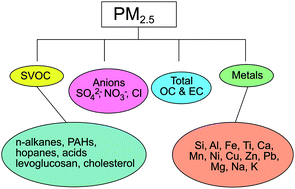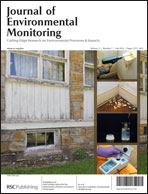Fine particle (PM2.5) samples have been collected at two sites in the UK West Midlands, representing urban background (EROS) and rural (CPSS) locations. Chemical quantification has been carried out for major anions, metal species, total OC and EC, and for individual organic marker species including n-alkanes, hopanes, PAHs, organic acids and sterols. Concentration levels of each chemical group are presented and the patterns of individual species used to infer predominant sources of atmospheric fine particles from atmospheric measurements. Temporal and spatial variations are also discussed. The annual mean PM2.5 concentrations were 11.6 and 10.5 µg m−3, with large daily variations (2.7–37.1 µg m−3) at the two sites. Elevated PM2.5 was mostly attributed to higher sulfate > OC > nitrate in summer and OC > nitrate > EC in winter. The mean levels of soil/dust related metals, Al > Si > Fe > Ca > Ti, were mostly different from other European sites due to differences in sampling site, local geology or climate, but comparable with earlier UK data. Trace metals, Zn > Cu > Pb > Mn > Ni, mostly showed lower concentrations compared with concentrations measured at the UK national metals network sites, except for Cu and Pb. The concentrations of PAHs were in a similar range to those previously measured within the UK, with an elevation at the urban site and in winter due to increased combustion activities, particularly for the two natural gas-related Oxy-PAHs. n-Alkanes showed a higher contribution in winter (low carbon preference index: 1.5–1.6) from anthropogenic emissions but in summer (high carbon preference index: 2.7–2.9) from biogenic sources, which are appreciable at our rural site (Cmax = 29). Similar levels of hopanes were observed at the urban (0.08–0.24 ng m−3) and the rural (0.07–0.23 ng m−3) site, with higher winter values at EROS as expected but opposite for CPSS. The concentrations of organic acids ranged from 0.19–10.2 ng m−3 at EROS and 0.26–6.0 ng m−3 at CPSS, with mixed patterns of seasonal variation (W/S: 0.54–2.0) for individual aliphatic and aromatic carboxylic acids, except the two resin acids which exhibited much higher levels in winter (W/S: 1.7–3.3) as expected due to higher wood smoke emissions. Cholesterol showed very low annual mean concentrations (0.13–0.16 ng m−3) confirming that meat cooking is not an important source at our sites.


 Please wait while we load your content...
Please wait while we load your content...